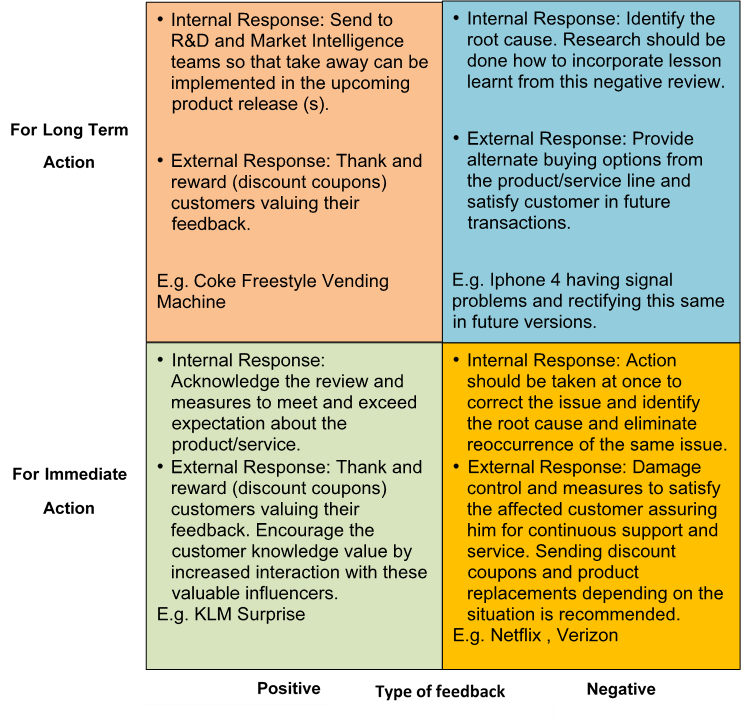CUSTOMER ENGAGEMENT SUITE
Customer Knowledge Value
Like Customer Referral Value (CRV) and Customer Influence Value (CIV), Customer Knowledge Value (CKV) is an indirect measure of a customer’s monetary contribution to a firm. But unlike those other two metrics, CKV is not concerned with a customer’s interactions with existing or prospective customers. Rather, CKV concerns a customer’s interactions with the firm itself, specifically those interactions which involve a transfer of knowledge the former to the latter. CKV, in effect, aims to measure the value accrued from any improvements within a firm that are attributable to the ideas or suggestions provided by a given customer (Kumar, V., and Yashoda Bhagwat (2010)).

From a voluntarily submitted idea or suggestion to actual implementation on behalf of a firm requires many intermediate steps. A firm must identify the most effective channel(s) for quality feedback, screen and analyze the incoming feedback data, and then determine which suggestions are most in need of being addressed and/or which are most viable for implementation. CKV then equates to all profits realized post-implementation. Firms with strong feedback incentives, well-designed feedback channels, effective analytical strategies stand to maximize CKV. Moreover, firms that supply their customer base with greater knowledge about the products and services they provide are likelier to receive well-informed feedback. CLV generally correlates with CKV, but after CLV rises above a certain threshold, the customer in question is generally at a level of satisfaction that precludes the desire to submit feedback.
Since customer feedback gets initiated through multiple channels, the following five-step strategy can be used to measure and manage customer feedback (Kumar, V. (2013)).
Step One:

The business will have to analyze the various channels through which customers provide feedback and identify those channels that provide significant and quality feedback that the business can use. Some of the popular channels used by businesses to gather feedback include point-of-purchase surveys, web-based surveys, telephone surveys, website feedback link, consumer user groups, focus groups, and follow-up surveys, among others.
Step Two:

The business will have to come up with mechanisms of integrating the channels to collect feedback data. Customer feedback is a resource, and it is wasted if not acted upon and used for improvement. By finding out and addressing customer concerns from the feedback, the companies’ gain solid understanding of customer needs, wants, and issues. That is, streamlining and consolidating all feedback data can provide valuable insights into what customers need, want, and value most. Further, it is not uncommon for unsatisfied customers to go the extra mile to narrate their experience with a product while most satisfied customers do not even jot it down. It is all the more important to create a customer feedback process for happy customers as it can be difficult to manage negative feedback once they appear in the public. Receiving negative feedback is inevitable at some point; however, it is important to remember that consumers want to see feedback and not just positive reviews as it would look like as the company has edited/delete bad reviews.
Step Three:

Businesses will have to adopt a standard way to normalize the data collected from the various channels to a “likert scale” of their choice that can be used for further analysis. Graphing the available data using advanced computer systems is another technique.
Steps Four & Five:

The business will need to analyze and classify the feedback data into useful information that can be used in generating CKV. The feedback information retrieved by the company can further be classified in a 2×2 matrix. As shown in the figure below, the Type of Feedback is represented on the x-axis (positive or negative) and the Time to Act on the y-axis (immediate or long term). A response for internal and external action is presented within the matrix. In order to analyze the genuineness of the feedback, the matrix can be completed with selected feedback received that is correlated with customer interactions such as product returns and service calls with complaints during the same timeframe.
Feedback Response Strategy

In this regard, feedback from popular sites (e.g. yelp, amazon, and mouthshut) can be collected and sorted out internally by a business. As we see the review/feedback reaction can be positive and negative and the action that should be taken from the business side could be immediate or long term. Similarly, the action from the business side can be an internal circular or a decision and there will be an external response to the customer by means of a forum, email or a social media website
References
Kumar, V., and Yashoda Bhagwat (2010), “Listen to Your Customers,” Marketing Research: A Magazine of Management and Applications, Vol. 22 (2), pp. 14-19.
Kumar, V. (2013), Profitable Customer Engagement: Concept, Metrics, and Strategies. New Delhi, India: Sage Publications.